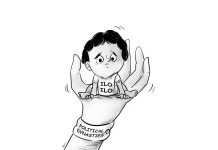
THE LOW, dark clouds, the rumble of thunder, the flashes of lightning, and the rising wind-bending branches all indicate a powerful typhoon is approaching, and that means danger, worry, and concern for the thousands of small farmers and their families and another week of loss, hunger, hardship, and survival.
City dwellers worry less with their strong buildings and water drainage systems to protect them. But living in a bamboo hut with a grass roof or flimsy metal sheet roofing is not secure against the force and might of the all-destructive typhoons and floods that frequently hit the Philippines and other Southeast Asian countries.
The consequence of climate change is here; there is no doubt the Philippines endured 19 typhoons and storms in 2022, and they are increasing in number. Every year, they destroy harvests, houses, roads, and river embankments and cause landslides, floods, death, and destruction.
Climate change continues to intensify and grow worse and more intense because of the non-stop burning of fossil fuels like coal and oil to generate electricity. They must be replaced with clean, renewable energy plants.
Yet, wealthy and secure politicians and business leaders ignore the dire threat to the nation and the planet. They do not see or care about the gathering catastrophe that is engulfing the planet and hurting children above all else.
Pope Francis does care, and millions more, and he has spoken out in strong criticism of the world order that does too little to stop global warming and save the planet.
The United Nations Children’s Fund (Unicef) has warned in a new report that children are the most vulnerable of all.
The world temperature is coming ever closer to the tipping point of no return when the global temperature reaches 1.5 degrees hotter since the pre-industrial era and cannot be reversed. That is when one disaster will cause another in an unstoppable chain reaction of destruction. Humans have caused this, and the 10 richest nations are 70 percent responsible for it all.
The children are the most vulnerable to climate change and at risk, according to the recent report from Unicef titled “The Climate Crisis is a Child Rights Crisis: Introducing the Children’s Climate Risk Index” launched recently at the UN headquarters in New York. This is part of an ongoing research project that analyses the vulnerability and risk factors of how climate change is endangering children. Children are impacted by storms, floods and landslides.
In other parts of the globe, drought kills everything. Children and people die. There are water-borne diseases from floods, loss of their possessions and flimsy bamboo and grass-roofed homes are blown away. This also causes psychological stress and diminishes their education and well-being.
If they are sent away to distant relatives because of poverty, they can suffer malnourishment and the loss of their parents’ love and protection. They are even vulnerable to physical and sexual abuse.
The Unicef report finds “approximately one billion children — nearly half the world’s 2.2 billion children — live in one of the 33 countries classified as “extremely high-risk.” The Philippines is 31 in ranking of this “high-risk” list of countries due to natural disasters caused by climate change. (To be continued)/PN







